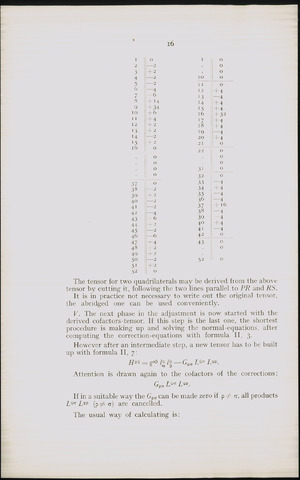1 1
2
1 0
0
i6
0
2
2
3
2
4
2
5
2
6
4
7
6
8
14
9
34
10
6
11
4
12
2
13
2
14
2
15
2
16
0
0
0
0
0
37
0
38
2
39
2
40
2
41
2
4 2
—4
43
6
44
2
45
2
46
—6
47
4
48
2
49
5°
C T
2
D 1
52
O
I
0
IO
0
I I
0
12
4
13
—4
14
4
15
4
16
32
r7
4
18
4
19
4
20
4
21
0
22
0
0
1 0
31
j 0
32
0
33
—4
34
4
35
—4
36
l—4
37
16
38
\—4
39
—4
40
4
41
—4
42
0
43
0
0
52
0
The tensor for two quadrilaterals may be derived from the above
tensor by cutting it, following the two lines parallel to PR and RS.
It is in practice not necessary to write out the original tensor,
the abridged one can be used conveniently.
V. The next phase in the adjustment is now started with the
derived cofactors-tensor. If this step is the last one, the shortest
procedure is making up and solving the normal-equations, after
computing the correction-equations with formula II, 3.
However after an intermediate step, a new tensor has to be built
up with formula II, 7:
H<ti, gap l* 7>p.
Attention is drawn again to the cofactors of the corrections:
Gpo L»p.
If in a suitable way the Gpn can be made zero if p a, all products
L^a Lfp (p^ a) are cancelled.
The usual way of calculating is:

